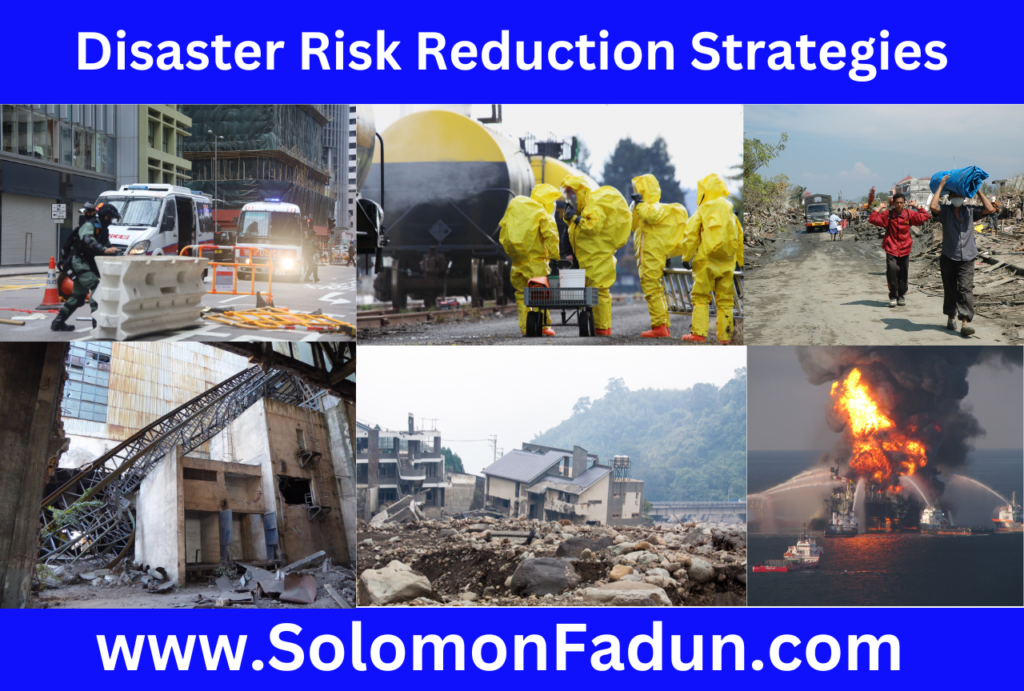Disaster Risk &
Disaster Risk Management

This post discusses disaster risk and disaster risk management. In this post, you will understand the meaning of disaster, disaster risk, disaster risk management, and disaster risk reduction strategies.
WHAT IS DISASTER?
The United Nations has defined disaster as a severe disruption of the functioning of a community or society, which involve widespread human, material, economic or environmental impacts that exceed the ability of the affected community or society to cope using its resources. Disaster management entails how we deal with the effects of disaster on humans, materials, the economy and the environment. It is how we prepare for, respond to and learn from the effects of major failures.
DISASTER MANAGEMENT
Disaster Management entails strategic planning and procedure administered and employed to protect critical infrastructures (also known as essential assets) from severe damages when natural or human-made calamities and catastrophes occur. Disasters can be natural or human-made events, including pandemics, technological disasters or environmental cataclysms. Disaster management plans are multi-layered and aim to address issues such as floods, hurricanes, fires, bombings, and even mass failures of utilities or the rapid spread of disease.
The disaster plan will likely address essential matters such as relinquishing people from an impacted region and arranging temporary housing, food, and medical care. When a hazardous event (such as a drought, flood, cyclone, earthquake or tsunami) occurs, triggering a loss of life and damage to infrastructure, it highlights the reality that society and its assets are vulnerable to such events.
When discussing disaster risk management, a disaster can highlight the geographical area where the community is settled and is exposed to such a hazard. The society (including individuals) and its infrastructure, assets and other processes – as well as services that may have experienced damage or destruction – are vulnerable. One of the biggest challenges of disaster management is the need to be prepared for a wide range of contingencies. An excellent place to begin a discussion of disaster management is by considering what constitutes a disaster.
TYPES OF DISASTER
Though vulnerability to disaster varies; but, no country is immune from tragedy or disaster. There are four main types of disasters: Natural disasters, Man-Made Disasters, Complex emergencies, and Pandemic emergencies.
1. NATURAL DISASTERS
Natural Disasters are naturally occurring physical phenomena caused by rapid or slow onset events that immediately impact human health and secondary impacts causing further death and suffering. These disasters include floods, hurricanes, earthquakes and volcano eruptions that can have immediate implications for human health, as well as secondary impacts causing further death and suffering from floods causing landslides, earthquakes resulting in fires, tsunamis causing widespread flooding and typhoons sinking ferries.
2. MAN-MADE DISASTERS
Man-Made Disasters are events caused by humans that occur in or close to human settlements, often caused by Environmental or Technological Emergencies. These emergencies include environmental degradation, pollution, and technological or industrial accidents, usually involving hazardous materials, and occur where these materials are produced, used or transported.
3. COMPLEX EMERGENCIES
Some disasters can result from multiple hazards or, more often, from a complex combination of natural and man-made causes which involve a breakdown of authority, looting and attacks on strategic installations, including conflict situations and war. These emergencies involve a power breakdown, looting and attacks on strategic facilities. Complex emergencies include conflict situations and war. Complex emergencies include food insecurity, epidemics, armed conflicts and displaced populations.
According to the International Federation of Red Cross and Red Crescent Societies, complex emergencies are typically characterised by:
i. Extensive violence,
ii. Displacements of populations,
iii. Loss of life,
iiii. Widespread damage to both societies and economies,
v. Need for large-scale, humanitarian assistance across multiple agencies,
vi. Political and military constraints which impact or prevent humanitarian assistance, and
vii. Increased security risks for humanitarian relief workers.
4. PANDEMIC EMERGENCIES
A pandemic is an infectious disease epidemic that has spread across a large region, which can occur to the human or animal population and may affect health and disrupt services leading to economic and social costs. It may be an unusual or unexpected increase in the number of cases of an infectious disease that already exists in a particular region or population or can also refer to the appearance of a significant number of cases of an infectious disease in an area or people that is usually free from that disease.
Pandemic emergencies may occur as a consequence of natural or man-made disasters. These emergencies involve a sudden onset of a contagious disease that affects health but also disrupts services and businesses, bringing economic and social costs. These have included the following epidemics: Ebola, Zika, Avian Flu, Cholera, Dengue Fever, Malaria, Yellow Fever and Coronavirus Disease (COVID-19).
DISASTER RISK
Disaster risk constitutes the potential loss of life, injury, or destroyed or damaged assets that could occur to a system, society or community in a specific period, determined probabilistically as a function of hazard, exposure, vulnerability and capacity. In the technical sense, disaster risk is associated with three interrelated terms: hazard, exposure and vulnerability. How a disaster affects society is a function of threat, vulnerability, and exposure.
To enhance our understanding of ‘disaster risk’, describing these three terms (hazard, exposure and vulnerability) is essential.
Hazard: Hazard is a process, phenomenon or human activity that may cause loss of life, injury or other health impacts, property damage, social and economic disruption or environmental degradation. Hazards may be single, sequential or combined in their origin and effects. Each hazard is characterised by its “location, intensity or magnitude, frequency, and probability”.
Exposure: Exposure entails people, infrastructure, housing, production capacities and other tangible human assets in hazard-prone areas. Consequently, exposure refers to people, property, systems or elements present in hazard zones that are thereby subject to potential losses. Exposure measures can include the number of people or types of assets in an area. These can be combined with the specific vulnerability and capacity of the exposed elements to any particular hazard to estimate the quantitative risks associated with that hazard in the area of interest.
Vulnerability: Vulnerability is the ability or resiliency of society to withstand a disaster. Vulnerability can also be described as the conditions determined by physical, social, economic and environmental factors or processes which increase the susceptibility of an individual, a community, assets or systems to the impacts of hazards.
Vulnerability is multi-dimensional in its nature, and next to the four dimensions above, some authors also include cultural and institutional factors. Examples include, but are not limited to, poor design and construction of buildings, inadequate protection of assets, lack of public information and awareness, high levels of poverty and education, limited official recognition of risks and preparedness measures, disregard for wise environmental management or weak institutions, and governance.
THE 4 PHASES OF DISASTER MANAGEMENT
When disaster strikes, businesses that close down risk never reopening – especially with no plan of action in place. While there is no way to lower the risk of a natural disaster or a widespread health crisis like COVID-19, there are critical measures that an organisation can take to protect its people, assets and bottom line in the wake of a disaster.
While creating a business continuity management plan for your organisation, consider the four phases of disaster management and how each phase will affect your business before, during and after a crisis. Phases of disaster management are known as disaster management cycle phases. Here are the 4 phases of disaster management takes place in four key phases:
1. Mitigation,
2. Preparedness,
3. Response, and
4. Recovery.
CATEGORIES OF DISASTER RISK MANAGEMENT ACTIONS
Disaster risk management actions can be classified into three categories: 1. Prospective disaster risk management,
2. Corrective disaster risk management, and
3. Compensatory disaster risk management – also known as residual risk management.
DISASTER RISK MANAGEMENT CYCLE
Disaster risks can be reduced through systematic efforts to analyse and manage the causal factors of disasters, including reduced exposure to hazards, lessened vulnerability of people and property, wise land and environment management, and improved preparedness for adverse events. If properly implemented, the disaster-management cycle can reduce the impact of a catastrophic event. It can also incorporate the policies and emergency responses needed for a full, expedited recovery.
Disaster risk management cycle comprises five stages:
1. Prevention,
2. Risk mitigation,
3. Preparedness,
4. Response, and
5. Recovery.
See a video on Disaster Risk & Disaster Risk Management: https://youtu.be/oj5tbAFDQYA

VIDEO TIMESTAMPS
00:00 – Introduction
00:33 – Definition of disaster
03:01 – Types of disaster
07:25 – Disaster risk
11:18 – The 4 phases of disaster management
16:37 – Identifying and understanding risk: The foundation of risk reduction
19:28 – Categories of disaster risk management actions
21:08 – Disaster risk reduction strategies
23:13 – Disaster risk management cycle
29:33 – Conclusion
